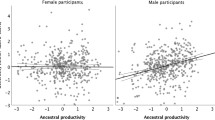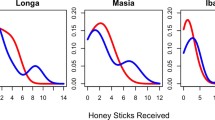Abstract
This paper examines social determinants of resource competition among Tsimane Amerindian women of Bolivia. We introduce a semi-anonymous experiment (the Social Strategy Game) designed to simulate resource competition among women. Information concerning dyadic social relationships and demographic data were collected to identify variables influencing resource competition intensity, as measured by the number of beads one woman took from another. Relationship variables are used to test how the affiliative or competitive aspects of dyads affect the extent of prosociality in the game. Using a mixed-modeling procedure, we find that women compete with those with whom they are quarreling over accusations of meat theft, mate competition, and rumor spreading. They also compete with members of their social network and with those who were designated as cooperative helpers or as close kin. Women take fewer beads from desired friends, neighbors, and from those viewed as enemies. We interpret favoritism toward enemies as resulting from fear of retribution. Our results suggest that social relations among women are multifaceted and often cannot be simplified by exclusive focus on genetic relatedness, physical proximity, or reciprocity. We argue that a complex understanding of cooperation and competition among women may require important contextual information concerning relationship history in addition to typical features of resource ecology.


Similar content being viewed by others
References
Anderson, C. M. (2000). The persistence of polygyny as an adaptive response to poverty and oppression in apartheid South Africa. Cross-Cultural Research, 34, 99–113.
Anderson, K. G., Kaplan, H., & Lancaster, J. (1999). Parental care by genetic and step fathers, I: Reports by men in Albuquerque, New Mexico. Evolution and Human Behavior, 20, 433–451.
Archer, J., & Coyne, S. M. (2005). An integrated review of indirect, relational, and social aggression. Personality and Social Psychology Review, 9, 212–230.
Bateman, A. J. (1948). Intra-sexual selection in Drosophila. Heredity, 2, 349–368.
Bjorkqvist, K., Lagerspetz, K. M. J., & Kaukiainen, A. (1992). Do girls manipulate and boys fight developmental trends in regard to direct and indirect aggression? Aggressive Behavior, 18, 117–127.
Borgerhoff Mulder, M. (1987). Resources and reproductive success in women, with an example from the Kipsigis. Journal of Zoology, 213, 489–505.
Buss, D. M. (1995). Psychological sex differences: Origins through sexual selection. American Psychologist, 50, 164–168.
Campbell, A. (1995). A few good men: Evolutionary psychology and female adolescent aggression. Ethology and Sociobiology, 16, 99–123.
Campbell, A. (2002). A mind of her own: The evolutionary psychology of women. New York: Oxford University Press.
Campbell, A., Muncer, S., Guy, A., & Banhim, M. (1996). Social representation of aggression: Crossing the sex barrier. European Journal of Social Psychology, 26, 135–147.
Cashdan, E. (1998). Are men more competitive than women? British Journal of Social Psychology, 37, 213–229.
Cashdan, E. (2003). Hormones and competitive aggression in women. Aggressive Behavior, 29, 107–115.
Chagnon, N. A. (1990). Reproductive and somatic conflicts of interest in the genesis of violence and warfare among tribesmen. In J. Haas (Ed.), Anthropology of war (pp. 77–104). New York: Cambridge University Press.
Cordain, L., Brand Miller, J., Boyd Eaton, S., et al. (2000). Plant-animal subsistence ratios and macronutrient energy estimations in worldwide hunter-gatherer diets. American Journal of Clinical Nutrition, 71, 682–692.
Crick, N. R. (1995). Relational aggression: The role of intent attributions, feelings of distress, and provocation type. Development and Psychopathology, 7, 313–322.
Cronk, L. (1994). Wealth, status and reproductive success among the Mukogodo of Kenya. American Anthropologist, 93, 345–360.
Darwin, C. (1871). The descent of man, and selection in relation to sex. London: J. Murray.
Eckel, C., & Grossman, P. (1998). Are women less selfish than men? Evidence from dictator experiments. Economic Journal, 108, 726–735.
Flinn, M., Geary, D., & Ward, C. (2005). Ecological dominance, social competition and coalitionary arms races: Why humans evolved extraordinary intelligence. Evolution and Human Behavior, 26, 10–46.
Forsythe, R., Horowitz, J. L., Savin, N. E., & Sefton, M. (1994). Fairness in simple bargaining experiments. Games and Economic Behavior, 6, 347–369.
Gurven, M. (2004). Economic games among the Amazonian Tsimane: Exploring the roles of market access, costs of giving, and cooperation on pro-social game behavior. Experimental Economics, 7, 5–24.
Gurven, M., & Walker, R. (2006). Energetic demand of multiple dependents and the evolution of slow human growth. Proceedings of the Royal Society of London. Series B, Biological Sciences, 273, 835–841.
Gurven, M., & Winking, J. (2008). Collective action in action: Prosocial behavior in and out of the laboratory. American Anthropologist, 110, 179–190.
Gurven, M., Kaplan, H., & Gutierrez, M. (2006). How long does it take to become a proficient hunter? Implications for the evolution of extended development and long lifespan. Journal of Human Evolution, 51, 454–470.
Gurven, M., Kaplan, H., & Supa, A. Z. (2007). Mortality experience of Tsimane Amerindians of Bolivia: Regional variation and temporal trends. American Journal of Human Biology, 19, 376–398.
Gurven, M., Zanolini, A., & Schniter, E. (2008). Culture sometimes matters: Intra-cultural variation in division norms among Tsimane Amerindians, real or spurious? Journal of Economic Behavior and Organization, 67, 587–607.
Hawkes, K., O’Connell, J. F., Blurton Jones, N. G., Alvarez, H., & Charnov, E. L. (1998). Grandmothering, menopause, and the evolution of human life histories. Proceedings of the National Academy of Sciences of the United States of America, 95, 1336–1339.
Henrich, J., Boyd, R., Bowles, S., et al. (2001). In search of Homo economicus: Experiments in 15 small-scale societies. American Economic Review, 91, 73–79.
Henrich, J., Boyd, R., Bowles, S., et al. (Eds.) (2004). Foundations of human sociality: Economic experiments and ethnographic evidence from fifteen small-scale societies. Oxford: Oxford University Press.
Hess, N. C. (2006). Informational warfare: The evolution of female coalitions and gossip. Ph.D. dissertation, University of California, Santa Barbara.
Hess, N. C., & Hagen, E. H. (2006a). Psychological adaptations for assessing gossip believability. Human Nature, 17, 337–354.
Hess, N. C., & Hagen, E. H. (2006b). Sex differences in indirect aggression: Psychological evidence from young adults. Evolution and Human Behavior, 27, 231–245.
Hurtado, A. M., Hawkes, K., Hill, K., & Kaplan, H. (1985). Female subsistence strategies among Ache hunter-gatherers of eastern Paraguay. Human Ecology, 13, 1–28.
Janson, C. H. (2000). Primate socio-ecology: The end of a golden age. Evolutionary Anthropology, 9, 73–86.
Kelly, R. L. (1995). The foraging spectrum: Diversity in hunter-gatherer lifeways. Washington: Smithsonian Institution Press.
Lamphere, L. (1977). The Navajo cultural system: An analysis of concepts of cooperation and autonomy and their relation to gossip and witchcraft. In M. Opler (Ed.), Apachean culture history and ethnology (pp. 91–114). Tucson: University of Arizona Press.
Lamphere, L., & Rosaldo, M. Z. (Eds.) (1974). Woman, culture and society. Palo Alto: Stanford University Press.
Lancaster, J. B. (1991). A feminist and evolutionary biologist looks at women. Yearbook of Physical Anthropology, 34, 1–11.
Levitt, S., & List, J. (2009). What do laboratory experiments tell us about the real world? Journal of Economic Perspectives, 21, 153–174.
Marlowe, F. (2001). Male contribution to diet and female reproductive success among foragers. Current Anthropology, 42, 755–760.
McGraw, K. J. (2002). Environmental predictors of geographic variation in human mating preferences. Ethology, 108, 303–317.
Parker, G. A., Baker, R. R., & Smith, F. C. F. (1972). The origin and evolution of gamete dimorphism and the male-female phenomenon. Journal of Theoretical Biology, 36, 529–553.
Pelegrini, A. D., & Bartini, M. (2001). Dominance in early adolescent boys: Affiliative and aggressive dimensions and possible functions. Merrill-Palmer Quarterly, 47, 142–163.
Roberts, G., & Sheratt, T. N. (1998). Development of cooperative relationships through increasing investment. Nature, 394, 175–179.
Rucas, S. L. (2004). Female intrasexual social behaviors among the Tsimane of Bolivia. Unpublished Ph.D. dissertation, Department of Anthropology, University of New Mexico.
Silk, J. (1983). Local resource competition and facultative adjustment of sex ratios in relation to competitive abilities. American Naturalist, 121, 56–66.
Silk, J. B., Alberts, S. C., & Altmann, J. (2003). Social bonds of female baboons enhance infant survival. Science, 302, 1231–1234.
Silk, J. B., Alberts, S. C., & Altmann, J. (2004). Patterns of coalition formation by adult female baboons in Amboseli, Kenya. Animal Behaviour, 67, 573–582.
Thaler, R. (1980). Toward a positive theory of consumer choice. Journal of Economic Behavior and Organization, 1, 39–60.
Underwood, M. K. (2003). Social aggression among girls. New York: Guilford.
Wagner, J. D., Flinn, M. V., & England, B. G. (2002). Hormonal response to competition among male coalitions. Evolution and Human Behavior, 23, 437–442.
Waynforth, D. (1999). Differences in time use for mating and nepotistic effort as a function of male attractiveness in rural Belize. Evolution and Human Behavior, 20, 19–28.
Wilson, M., & Daly, M. (1985). Competitiveness, risk-taking, and violence: The young male syndrome. Ethology and Sociobiology, 6, 59–73.
Wrangham, R. W., & Peterson, D. (1996). Demonic males: Apes and the origins of human violence. New York: Houghton Mifflin.
Yamaguchi, H. (1992). Formations of grand coalition when consciousness of intragroup competition is activated. Japanese Journal of Psychology, 62, 357–363.
Acknowledgments
We would like to thank the Tsimane women of our host communities for their gracious participation and wonderful camaraderie. This research was funded by LAII Field Research Grants, provided by the Tinker Foundation, and by NSF grant BCS-013274. We would also like to thank Dan Fessler, Steve Gangestad, and our anonymous reviewers for their helpful criticisms.
Author information
Authors and Affiliations
Corresponding author
Rights and permissions
About this article
Cite this article
Rucas, S.L., Gurven, M., Kaplan, H. et al. The Social Strategy Game. Hum Nat 21, 1–18 (2010). https://doi.org/10.1007/s12110-010-9079-z
Published:
Issue Date:
DOI: https://doi.org/10.1007/s12110-010-9079-z




